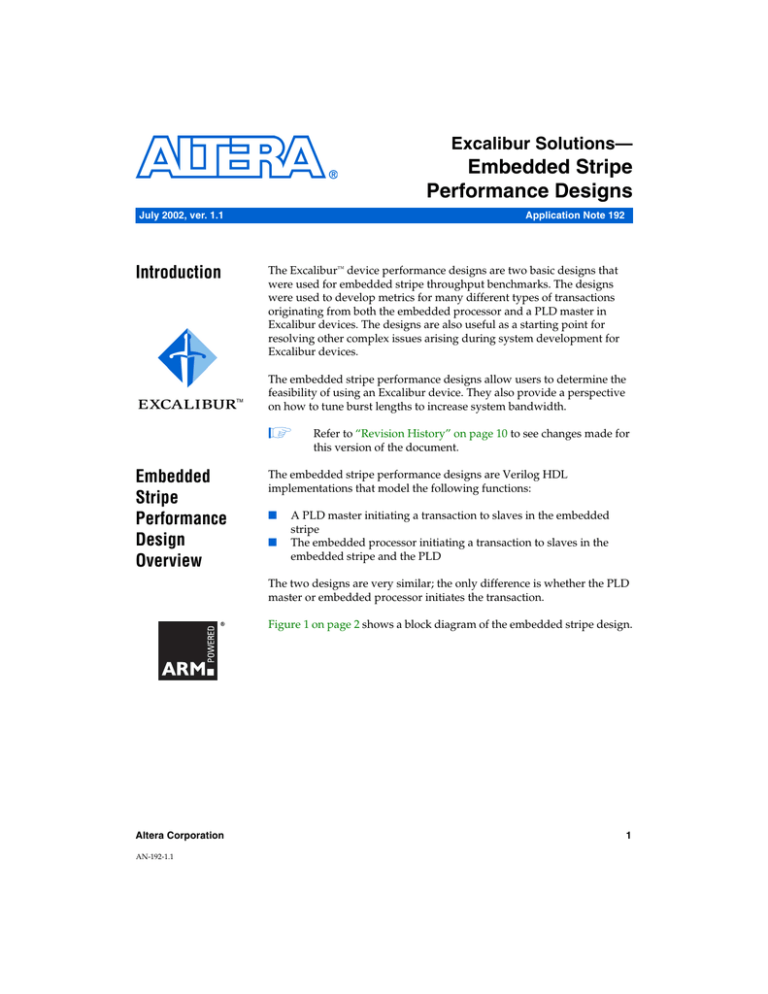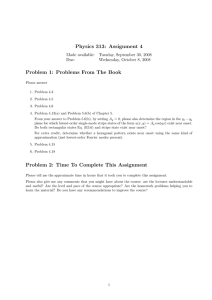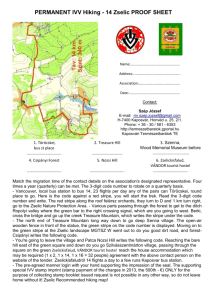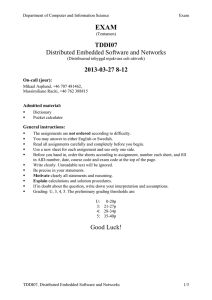
Excalibur Solutions—
Embedded Stripe
Performance Designs
July 2002, ver. 1.1
Introduction
Application Note 192
The Excalibur™ device performance designs are two basic designs that
were used for embedded stripe throughput benchmarks. The designs
were used to develop metrics for many different types of transactions
originating from both the embedded processor and a PLD master in
Excalibur devices. The designs are also useful as a starting point for
resolving other complex issues arising during system development for
Excalibur devices.
The embedded stripe performance designs allow users to determine the
feasibility of using an Excalibur device. They also provide a perspective
on how to tune burst lengths to increase system bandwidth.
Embedded
Stripe
Performance
Design
Overview
Refer to “Revision History” on page 10 to see changes made for
this version of the document.
The embedded stripe performance designs are Verilog HDL
implementations that model the following functions:
■
■
A PLD master initiating a transaction to slaves in the embedded
stripe
The embedded processor initiating a transaction to slaves in the
embedded stripe and the PLD
The two designs are very similar; the only difference is whether the PLD
master or embedded processor initiates the transaction.
Figure 1 on page 2 shows a block diagram of the embedded stripe design.
Altera Corporation
AN-192-1.1
1
AN 192: Excalibur Solutions—Embedded Stripe Performance Designs
Figure 1. Embedded Stripe Performance Design
Embedded
Processor
Memory
Embedded
Stripe
SRAM
EBI
AHB1to AHB2
Bridge
SDRAM
Controller
Embedded
Stripe
DPRAM
AHB2
PLD-to-Stripe
Bridge
Stripe-to-PLD
Bridge
DPRAM
PLD
Interface
PLD
Master
Installation
MT48LC4M32B2
Micron SDRAM
Model
AHB1
PLD
Slave
The DPRAM interface is not used in the embedded stripe design
shown in Figure 1.
Software Requirements
The following software is necessary to implement the embedded stripe
performance designs:
■
■
■
The Quartus® II software, version 2.1
ARM Developer Suite for Altera (Altera ADS-Lite) software, version
1.1, or Redhat GNUPro toolkit
Model Technology™ ModelSim® software, version 5.6a
Directory Structure
There are multiple projects in the stripeperformance.zip file.
To install the embedded stripe performance designs, unzip
stripeperformance.zip into the installation directory of your choice.
2
Altera Corporation
AN 192: Excalibur Solutions—Embedded Stripe Performance Designs
After the installation, the directory structure is as follows:
<Installation Directory>\stripe_performance
\pld_master
\Ads
\simulation
\Modelsim
\software
\Gnu
\simulation
\Modelsim
\software
\rtl
\testbench
\microprocessor
\Ads
\simulation
\Modelsim
\software
\Gnu
\simulation
\Modelsim
\software
\rtl
\testbench
The top-level directories for the two designs are \pld_master and
\microprocessor, but the subordinate directory structure for each is
identical. Within each of the top level directories there are two separate
Quartus projects. The \Ads directory contains a Quartus project with the
ADS tool chain settings and the \Gnu directory contains a Quartus
project with the GNU tool chain settings.
The projects for the software tool chain that is not in use can be
ignored or deleted.
Depending on the software tool chain that is used, the \Ads or the \Gnu
directory will be the working Quartus project directory. The Quartus
project directory contains Quartus project settings files, MegaWizard®generated files, and a batch file that is used to produce simulation
initialization files (sbd2sim_asm.bat).
Altera Corporation
3
AN 192: Excalibur Solutions—Embedded Stripe Performance Designs
Tables 1 to 5 detail the files in the directory structure for the two designs.
Table 1. File in the <Installation Directory>\stripe_performance\<PLD_master or microprocessor>\<Ads or
Gnu>\software
File
Description
Performance.s
Assembly file that is used to for embedded stripe register setup in
both cases and execute transactions in uP case. The assembly files
for ads and gnu differ
Table 2. Files in the <Installation Directory>\stripe_performance\<PLD_master or microprocessor>\rtl
File
Description
Ahb_include.v
Include file that contains a definition of parameters for the design. In
the case of the PLD master it is also used to change the address,
data and burst length of transactions
bfm_master.v
Master port of the BFM
Burst_slave.v
PLD slave that accepts transaction from both the PLD master and
the uP
Mt48lc4m32b2.v
128 Myte × 32 Micron SDRAM model. www.micron.com
Regfile.v
Simple memory model that is attached to the EBI
Slaveregfile.v
Register file for PLD slave
Stripe_performance.v
Top-level design file
The contents of the ./simulation/Modelsim directory of the two designs
differ slightly. The contents are summarized in Tables 3 and 4.
Table 3. Files in the <Installation Directory>\stripe_performance\microprocessor\<Ads or
Gnu>\simulation\Modelsim
File
Description
Compile_and_run_rtl_fullmodel_v.do
Compiles and runs all the files necessary for functional simulation
Wave.do
Modelsim waveform file
Modelsim.mpf
Modelsim project file
Table 4. Files in the the <Installation Directory>\stripe_performance\PLD_master\<Ads or
Gnu>\simulation\Modelsim (Part 1 of 2)
File
Description
Compile_and_run_rtl_fullmodel_v.do
Compiles and runs all the files necessary for functional simulation
Wave.do
Modelsim waveform file
4
Altera Corporation
AN 192: Excalibur Solutions—Embedded Stripe Performance Designs
Table 4. Files in the the <Installation Directory>\stripe_performance\PLD_master\<Ads or
Gnu>\simulation\Modelsim (Part 2 of 2)
File
Description
Modelsim.mpf
Modelsim project file
Slavememory.cfg.dat
BFM required file. Not used in this application
Input_dpram.dat
Input stimulus file that targets DPRAM
Input_ebi.dat
Input stimulus file that targets the EBI
Input_pld_slave.dat
Input stimulus file that targets the slave in the pld
Input_sdram.dat
Input stimulus file that targets the SDRAM controller
Input_sram.dat
Input stimulus file that targets SRAM
Table 6 identifies the file in the .\stripeperformance\testbench directory.
Table 5. File in the <Installation Directory>\stripe_performance\testbench
File
Stripeperformance_tb.v
Embedded
Stripe
Performance
Designs
Description
Design testbench
The embedded stripe performance designs are Verilog HDL
implementations that model a PLD master and the embedded processor
communicating to various slaves in the embedded stripe and a slave in the
PLD. The designs take advantage of the fact that the embedded stripe
model is a cycle-accurate model so that cycles can be counted to determine
performance.
The embedded processor and the PLD master move a total of 64 words of
data to different slaves in the design. The burst length of the transactions
is varied to measure their effect on sustained throughput. One IDLE cycle
is inserted after each burst. For example, two of the burst-length options
for the PLD master are to initiate one burst of length 64 or 16 bursts of
length 4 with one IDLE cycle between each burst.
The purpose of the one IDLE cycle is to allow time for the buffers involved
in the transactions to clear. Depending on the peripherals involved in the
transactions, inserting IDLE cycles can increase throughput. The
embedded stripe performance designs allow users to vary the burst length
and IDLE cycles between bursts, to observe their effects on throughput.
See “Changing Designs” on page 9 for details.
Altera Corporation
5
AN 192: Excalibur Solutions—Embedded Stripe Performance Designs
The clock speeds for the designs are shown in Table 6:
Table 6. Embedded Stripe Performance Clock Speeds
Clock
CLK_REF
Frequency
(MHz)
50
Description
Stripe reference clock
MASTER_HCLK
100
Stripe-to-PLD bridge clock
SLAVE_HCLK
100
PLD-to-stripe bridge clock
SDRAM_CLK
100
SDRAM clock
EBI_CLK
100
External EBI clock
AHB1_CLK
200
AHB1 clock
AHB2_CLK
100
AHB2 clock
Embedded Stripe Performance Processor Design
In the embedded stripe performance processor design, the embedded
processor is a master initiating transactions to the following locations:
■
■
■
■
■
Embedded processor → SRAM
Embedded processor → dual-port SRAM
Embedded processor → SDRAM (SDR running at 100 MHz)
AHB1-2 Bridge → EBI
Embedded processor → AHB1-2 bridge → stripe-to-PLD bridge →
PLD slave
Before the embedded processor starts to initiate transactions, the code
executing the transactions is locked into the cache for fast access and the
SDRAM controller is initialized. The transactions are simple in-line load
and store operations. One slave is targeted per simulation run, and a
different slave can be targeted by changing the MOD_UNDERTEST variable
in the embedded software. The code below declares the MOD_UNDERTEST
variable. It is located in performance.s file in the ./software directory.
Only one line should be un-commented per simulation run. Figure 2 on
page 7 shows the ADS version of the declaration; Figure 3 shows the GNU
version.
6
Altera Corporation
AN 192: Excalibur Solutions—Embedded Stripe Performance Designs
Figure 2. ADS Version of MOD_UNDERTEST Declaration
;***********************************************************************
;
Module undertest definition
;***********************************************************************
;
Only uncomment one MOD_UNDERTEST definition
;***********************************************************************
;;
;MOD_UNDERTEST
EQU
EXC_PLD_BLOCK0_BASE
;;PLD Base
;MOD_UNDERTEST
EQU
EXC_SDRAM_BLOCK0_BASE ;;SDRAM Base
;MOD_UNDERTEST
EQU
EXC_EBI_BLOCK0_BASE
;;EBI Base
;MOD_UNDERTEST
EQU
EXC_SPSRAM_BLOCK1_BASE ;;SRAM1 Base
;MOD_UNDERTEST
EQU
EXC_DPSRAM_BLOCK0_BASE ;;DPRAM0 Base
Figure 3. GNU Version of MOD_UNDERTEST Declaration
/*----------------------------------------------------------------------Module undertest definition
------------------------------------------------------------------------Only uncomment one MOD_UNDERTEST definition
-----------------------------------------------------------------------*/
//#define MOD_UNDERTEST
#define MOD_UNDERTEST
//#define MOD_UNDERTEST
//#define MOD_UNDERTEST
//#define MOD_UNDERTEST
EXC_PLD_BLOCK0_BASE
EXC_SDRAM_BLOCK0_BASE
EXC_EBI_BLOCK0_BASE
EXC_SPSRAM_BLOCK1_BASE
EXC_DPSRAM_BLOCK0_BASE
//PLD Base
//SDRAM Base
//EBI Base
//SRAM1 Base
//DPRAM0 Base
/*---------------------------------------------------------------------*/
Embedded Stripe Performance PLD Master Design
The embedded stripe performance PLD master design has a modified
version of the bus functional model (BFM) attached to the PLD-to-stripe
bridge. Input stimulus files are provided to simulate transactions to the
following locations:
■
■
■
■
Altera Corporation
BFM_Master → PLD-to-stripe bridge → SRAM
BFM_Master → PLD-to-stripe bridge → DPRAM
BFM_Master → PLD-to-stripe bridge → SDRAM (SDR running at 100
MHz)
BFM_Master → PLD-to-stripe bridge → EBI
See the Bus Functional Model User Guide for details on the BFM and the
input stimulus files.
7
AN 192: Excalibur Solutions—Embedded Stripe Performance Designs
Before the BFM_Master starts to initiate transactions, the code executing
the transactions is locked into the cache and the SDRAM controller is
initialized. After SDRAM initialization, the embedded processor writes to
a register in the PLD to enable the BFM_Master. When the BFM_Master
has been enabled, the embedded processor is put into an endless loop,
preventing it from affecting the performance of the BFM_Master.
Simulating
Embedded
Stripe
Performance
Designs
Running a simulation of an embedded stripe performance design consists
of the following steps:
1.
Open the appropriate Quartus project:
■
■
<Installation Directory>\ pld_master\ads or
gnu\stripe_performance.quartus
<Installation Directory>\ microprocessor>\ads or
gnu\stripe_performance.quartus
2.
Switch to Software Mode
3.
Set the toolset selection to the ADS standard tools or GNUPro for
ARM
4.
Start a software build
5.
Open the appropriate ModelSim project:
■
6.
<Installation Directory>\pld_master\ads or
gnu\simulation\Modelsim
■ <Installation Directory>\microprocessor>\ads or
gnu\simulation\Modelsim
Run the simulation script; at the ModelSim prompt type do
Compile_and_run_rtl_fullmodel_v.do
In the pld_master simulation, a menu is displayed to allow you to
select which slave you would like the BFM_Master to target. See
Figure 4 on page 9. Select a number from 1 to 5 to select the peripheral
to be targeted.
8
Altera Corporation
AN 192: Excalibur Solutions—Embedded Stripe Performance Designs
Figure 4. Slave Targeting Dialogue
"*****************************************************************
“Please enter an integer between 1 to 5 to select the slave targeted by the
BFM_master”
1 BFM_master->PLD-to-Stripe Bridge -> SRAM
2 BFM_master->PLD-to-Stripe Bridge -> SDRAM
3 BFM_master->PLD-to-Stripe Bridge -> Stripe-to-PLD Bridge ->PLD Slave
4 BFM_master->PLD-to-Stripe Bridge -> DPRAM
5 BFM_master->PLD-to-Stripe Bridge -> EBI
******************************************************************
The simulation run terminates without further interaction.
7.
Observe the waveform output
Changing
Designs
For detailed information on the Excalibur device hardware
design flow, see the Excalibur Hardware Design Tutorial.
At present, the embedded stripe performance designs are configured to
perform a specific set of transactions for evaluating performance. The
embedded stripe performance designs are also very flexible and allow for
other types of operations to be performed.
The real power of the designs is their flexibility and can be used to resolve
issues other than those relating to performance.
Changing the Embedded Stripe Performance Processor Design
The transactions in the embedded stripe performance processor design
are initiated by embedded software, facilitating change. Any assembly
command can be added to the current design, recompiled, and simulated.
Changes to the memory map can by made by running the MegaWizard;
no other changes to the design files are necessary. The only thing to note
is that the simulation stops when the value 64 is loaded into register r10.
The instruction that loads 64 into r10 is currently the last line of code
executed in performance.s.
Altera Corporation
9
AN 192: Excalibur Solutions—Embedded Stripe Performance Designs
Changing the Embedded Stripe Performance PLD Master Design
The BFM emulates a master connected to the PLD-to-stripe bridge. It
provides a flexible master that can be used to initiate transactions to any
location in the memory map. At present, by choosing a target slave using
the menu shown in Figure 4, a different input stimulus file (which is
located in the. /simulation/modelsim directory) is passed to the bus
translator. To make changes to the design, change the appropriate input
stimulus file (adhering to the bus functional language syntax) and select
that file from the menu. If you change the memory map, the memory
locations in the input stimulus file must also be changed to match.
Currently, the testbench waits for 64 to be valid on the read-data
port of the BFM master. The transactions are set up with the last
transaction occurring to a location to which 64 was written. If this
portion of the design is changed, simulation must either be
stopped manually, or the testbench must change to
accommodate the changes.
Conclusion
The embedded stripe performance designs provide designers with a
starting point for determining the feasibility of implementing their
application in the Excalibur devices. The design is a Verilog HDL
implementation that bursts 64 words of data to different slaves in the
system. Changes are easily implemented by modifying embedded
software or input stimulus files.
Revision
History
Table 7 shows the document revision history.
Table 7. Revision History
Date
10
Description
March 2002
First publication
July 2002
Modifications to accommodate GNUPro tools
Altera Corporation
AN 192: Excalibur Solutions—Embedded Stripe Performance Designs
Altera Corporation
11
AN 192: Excalibur Solutions—Embedded Stripe Performance Designs
101 Innovation Drive
San Jose, CA 95134
(408) 544-7000
http://www.altera.com
Applications Hotline:
(800) 800-EPLD
Literature Services:
lit_req@altera.com
12
Copyright © 2002 Altera Corporation. All rights reserved. Altera, The Programmable Solutions Company, the
stylized Altera logo, specific device designations, and all other words and logos that are identified as
trademarks and/or service marks are, unless noted otherwise, the trademarks and service marks of Altera
Corporation in the U.S. and other countries. All other product or service names are the property of their
respective holders. Altera products are protected under numerous U.S. and foreign patents and pending
applications, maskwork rights, and copyrights. Altera warrants performance of its
semiconductor products to current specifications in accordance with Altera’s standard
warranty, but reserves the right to make changes to any products and services at any time
without notice. Altera assumes no responsibility or liability arising out of the application
or use of any information, product, or service described herein except as expressly agreed
to in writing by Altera Corporation. Altera customers are advised to obtain the latest
version of device specifications before relying on any published information and before
placing orders for products or services.
Altera Corporation





